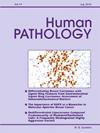膀胱浆细胞样尿路上皮癌:一个专注于下一代测序(NGS)和PD-L1免疫组织化学的单一机构经验
IF 2.7
2区 医学
Q2 PATHOLOGY
引用次数: 0
摘要
膀胱浆细胞样尿路上皮癌(PUC)是一种侵袭性UC亚型,其特征是浸润细胞呈浆细胞样外观,体细胞CDH1突变导致e -钙粘蛋白丢失。2018 - 2024年病理档案共发现32例PUC;18例进行了新一代测序(NGS),所有32例进行了PD-L1免疫组化。计算PD-L1肿瘤比例评分(TPS)和联合阳性评分(CPS)。生存率分析采用Kaplan-Meier法和log-rank检验。患者中位年龄为72.5岁(IQR: 64.3-78.8岁)。该队列主要由男性组成(29/ 32,91%)。25例(78%)患者行根治性膀胱切除术/膀胱前列腺切除术(RC), 7例(22%)行经尿道切除术。中位肿瘤大小为5.2 cm (IQR为3.6-8.0 cm)。大多数RCs(22/ 25,88 %)为高分期(pT3-4)。22/25例RCs(88%)存在淋巴血管侵犯,12/23例RCs(52%)存在pN1-2。17/32例(53%)PD-L1 TPS≥1%(6/17例接受免疫检查点抑制剂- ICIs), 21/32例(66%)CPS≥1%(8/21例接受ICIs)。反复突变的基因包括TP53、TERT、RB1、CREBBP和ERBB2等;我们的NGS面板不包括CDH1。最常见的拷贝数改变是RB1、CDKN2A和CDKN1B的丢失。中位肿瘤突变负荷(TMB)为10.3 mut/Mb (IQR为5.4-15.73 mut/Mb)。中位总生存期(OS)为13.0个月(95% CI 4.2-21.8个月),有证据表明PD-L1表达患者的OS更好。总体而言,PUCs经常表现出高TMB和/或PD-L1表达,这表明有可能使用ICIs进行干预。最后,NGS被推荐用于识别可操作的改变,包括ERBB2突变。本文章由计算机程序翻译,如有差异,请以英文原文为准。
Plasmacytoid urothelial carcinoma of the urinary bladder: A single institution experience with focus on next-generation sequencing (NGS) and PD-L1 immunohistochemistry
Plasmacytoid urothelial carcinoma (PUC) of the urinary bladder is an aggressive UC subtype characterized by infiltrating cells with plasmacytoid appearance, and somatic CDH1 mutations leading to E-cadherin loss. 32 PUC cases were found in our pathology archives from 2018 to 2024; next-generation sequencing (NGS) was available in 18 cases, and PD-L1 immunohistochemistry in all 32 cases. PD-L1 tumor proportion score (TPS) and combined positive score (CPS) were calculated. Kaplan-Meier method and log-rank test were used for survival analysis. Median patient age was 72.5 years (IQR: 64.3–78.8 years). The cohort consisted predominantly of males (29/32, 91%). 25 patients (78%) underwent radical cystectomy/cystoprostatectomy (RC), while 7 (22%) transurethral resection. Median tumor size was 5.2 cm (IQR of 3.6–8.0 cm). Most RCs (22/25, 88 %) were high-stage (pT3-4). Lymphovascular invasion was identified in 22/25 RCs (88%) and 12/23 RCs (52%) were pN1-2. 17/32 cases (53%) showed a PD-L1 TPS≥1% (6/17 received immune-checkpoint inhibitors – ICIs), while 21/32 (66%) exhibited a CPS≥1% (8/21 received ICIs). Recurrently mutated genes included TP53, TERT, RB1, CREBBP, and ERBB2, among others; our NGS panel does not cover CDH1. Most frequent copy number alterations were RB1, CDKN2A, and CDKN1B losses. Median tumor mutational burden (TMB) was 10.3 mut/Mb (IQR 5.4–15.73 mut/Mb). Median overall survival (OS) was 13.0 months (95% CI 4.2–21.8 months) with some evidence for superior OS among patients with PD-L1 expression. Overall, PUCs frequently exhibit high TMB and/or PD-L1 expression, suggesting a potential for intervention with ICIs. Finally, NGS is recommended to identify actionable alterations, including ERBB2 mutations.
求助全文
通过发布文献求助,成功后即可免费获取论文全文。
去求助
来源期刊

Human pathology
医学-病理学
CiteScore
5.30
自引率
6.10%
发文量
206
审稿时长
21 days
期刊介绍:
Human Pathology is designed to bring information of clinicopathologic significance to human disease to the laboratory and clinical physician. It presents information drawn from morphologic and clinical laboratory studies with direct relevance to the understanding of human diseases. Papers published concern morphologic and clinicopathologic observations, reviews of diseases, analyses of problems in pathology, significant collections of case material and advances in concepts or techniques of value in the analysis and diagnosis of disease. Theoretical and experimental pathology and molecular biology pertinent to human disease are included. This critical journal is well illustrated with exceptional reproductions of photomicrographs and microscopic anatomy.
 求助内容:
求助内容: 应助结果提醒方式:
应助结果提醒方式:


